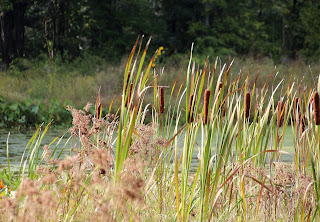 |
| Kali dispersing common milkweed (Asclepias syriaca) seeds |
The 100-acre Paunacussing (named for the creek that rises on the land) contains active agriculture, farmland converted to native meadows, meadows undergoing active afforestation, woodlots, and a large pond. Topographically, it is fairly level and walking was easy.
We set off on paths cut through native goldenrod meadows in full bloom.
 |
| Old fence post festooned with Virginia creeper (Parthenocissus quinquefolia) |
 |
| Cooperative azure damselfly perched in the meadow |
 |
| Thistle gone to seed exposing its silvery underbelly |
 |
| Vultures |
 |
| The pond |
Beavers have colonized the pond. Preston explained that he didn't want beavers in the pond because they were cutting down trees and because they were blocking up the outlet channel and the agri-drain system that NLT installed to allow land managers to manipulate the water level. He said that he had been in contact with the Pennsylvania Game Commission about removing the beavers. Kali and I do not believe he made a compelling case for removing the beavers.
 |
| A beaver's handiwork at the edge of the pond |
 |
| Cattails (Typha spp.) |
 |
| Cattails and green-headed (or cut-leaf) Coneflowers (Rudbeckia laciniata) |
 |
| A moss-softened path |
 |
| Preserve manager Preston Wilson (light shirt) explaining the deer exclosure |
 |
| Note the dense auburn hairs plus the much longer, less-dense lighter hairs |
 |
| Afforestation area with an Eastern Bluebird nesting box |




2 comments:
That looks like a really nice place for a walk. I like the work and efforts by the NLT there. The beaver-chewed tree is such a fine image. I hope the beavers are protected rather than removed.
Alas, I believe the beavers are going to go unless there's some other intervention. One of the things that puzzled me was that he planned to have the Game Commission capture them in the winter. maybe that's when they're holed-up in their lodge and easy to catch. But, it seems to me that it would be impossible to relocate them successfully in the winter when they have no food reserves in a new location. It makes me suspicious that perhaps they're not going to be relocated...
Post a Comment